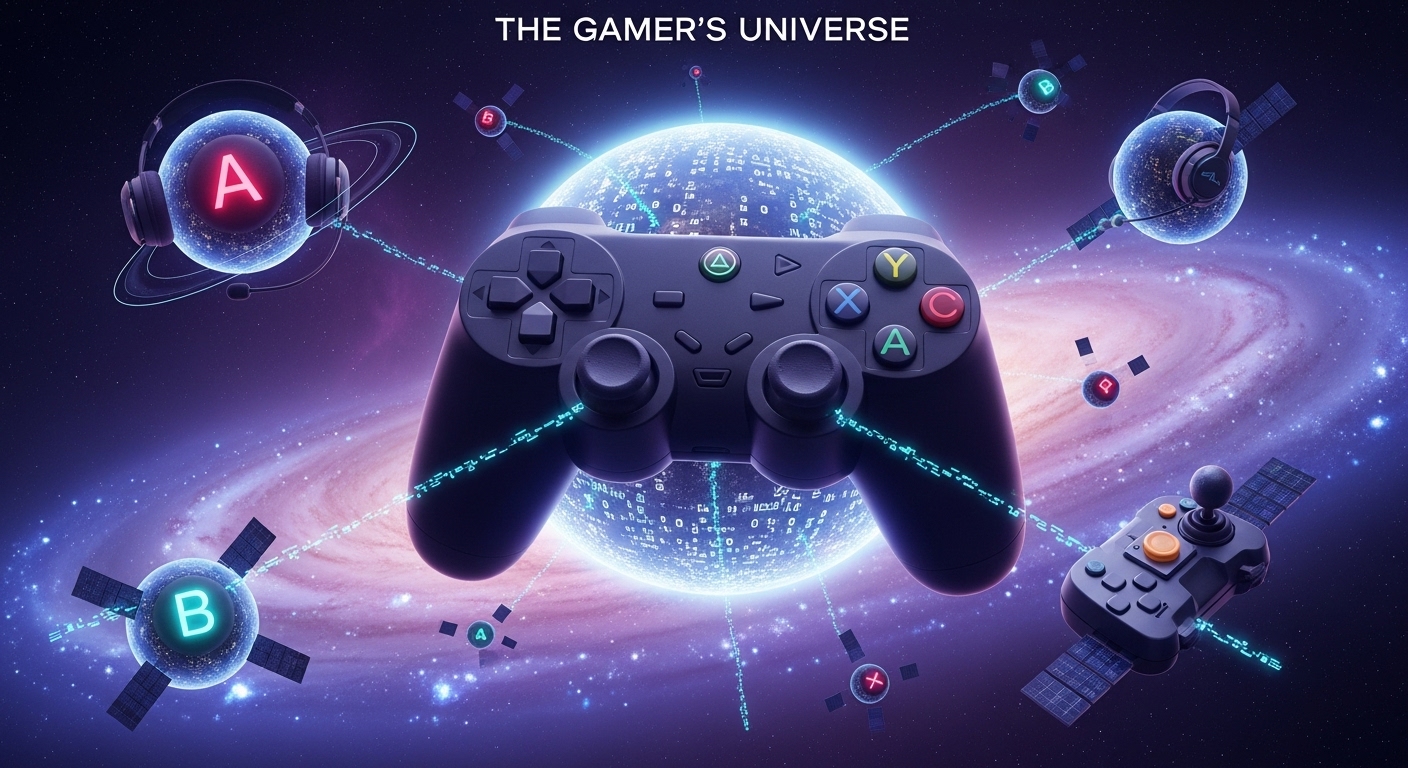Video games have evolved from simple pixelated screens to hyper-realistic, sprawling worlds that captivate millions of players worldwide. What began as a niche hobby in the 1970s has grown into a multi-billion-dollar industry that influences entertainment, culture, and technology. In this post, we will explore the evolution of video gaming, from its humble beginnings in arcades to the immersive experiences provided by modern consoles and virtual reality. Join us as we dive into the past, present, and future of video games.
The Birth of Video Games: The 1950s and 1960s
The idea of interactive entertainment is not as new as it may seem. The history of video games can be traced back to the 1950s and 1960s when pioneers in computing began experimenting with computer simulations. One of the first-ever examples of a video game was Tennis for Two, created by physicist William Higinbotham in 1958. Displayed on an oscilloscope, this simple game allowed two players to control paddles and hit a ball back and forth on a screen.
However, it was Spacewar!, developed by Steve Russell in 1962, that became the first widely recognized video game. It ran on the PDP-1 computer and allowed two players to control spaceships engaged in a dogfight. Spacewar! was a breakthrough in interactive entertainment, but it remained largely a niche experience, played only by those with access to computers.
The Arcade Era: The 1970s and 1980s
The 1970s marked the beginning of the video game industry we recognize today. In 1972, Nolan Bushnell, founder of Atari, released Pong, a simple yet addictive two-player ping-pong game that was an immediate success in arcades. Pong was the first commercially successful video game, and it quickly led to the proliferation of arcade machines across the United States.
As the popularity of arcade games soared, more developers jumped on board, creating new and innovative experiences. Space Invaders (1978), Pac-Man (1980), Donkey Kong (1981), and Ms. Pac-Man (1982) became household names and symbols of the 1980s gaming culture. The arcade experience was defined by the rush of competition, the joy of high scores, and the quest for dominance among friends and strangers alike.
During this time, home consoles began to gain traction. In 1977, Atari released the Atari 2600, one of the first successful home video game consoles. This home console allowed players to experience arcade-style games at home, setting the stage for the future of video gaming. Despite facing stiff competition from the likes of the Magnavox Odyssey and Intellivision, the Atari 2600 became synonymous with the early days of home gaming. However, by the mid-1980s, the video game market experienced a significant downturn, known as the “Video Game Crash of 1983,” largely due to market saturation and low-quality games.
The Rise of Nintendo and the Renaissance of Home Consoles
Following the crash of 1983, the video game industry was in a state of disarray. But by the mid-1980s, Nintendo stepped in and revitalized the industry. In 1985, Nintendo released the Nintendo Entertainment System (NES), which quickly became a success due to its high-quality games, innovative hardware, and strong third-party support.
The NES introduced players to iconic franchises that would go on to define the gaming landscape for decades. Super Mario Bros., The Legend of Zelda, and Metroid became the cornerstones of Nintendo’s portfolio and helped establish gaming as a legitimate form of entertainment. Nintendo’s strict quality control also helped ensure that third-party developers would create high-quality games, further bolstering the success of the NES.
Meanwhile, Sega emerged as a formidable competitor in the gaming market. The Sega Genesis, released in 1988, introduced games like Sonic the Hedgehog, which provided fast-paced, action-packed gameplay. The console wars between Nintendo and Sega dominated the 1990s, with both companies releasing innovative hardware and competing for market share. Sega’s Sonic became an icon in its own right, while Nintendo continued to dominate with games like Super Mario World and The Legend of Zelda: A Link to the Past.
The Transition to 3D: The 1990s and Early 2000s
The 1990s marked a major shift in the world of video games. The development of 3D graphics revolutionized the way games were played and perceived. In 1991, Sega introduced the Sega Saturn, a console capable of rendering 3D graphics. However, it was Sony’s 1994 release of the PlayStation that really marked the beginning of the 3D era.
The PlayStation was the first home console to offer fully 3D gameplay, and it was home to landmark games like Gran Turismo, Final Fantasy VII, and Metal Gear Solid. These games pushed the boundaries of what was possible in terms of storytelling, game design, and graphics. Final Fantasy VII, in particular, was a turning point in the RPG genre, offering deep narratives and cinematic sequences that appealed to a wide audience.
At the same time, Nintendo embraced 3D gaming with the release of the Nintendo 64 in 1996. The N64 introduced groundbreaking games like Super Mario 64, The Legend of Zelda: Ocarina of Time, and GoldenEye 007. These games showcased the potential of 3D worlds, offering players expansive, interactive environments that were previously unheard of in the industry. The Nintendo 64 also introduced analog sticks, which became a standard feature in future controllers.
During this period, the PC gaming market was also booming, with titles like Warcraft II, Starcraft, and Half-Life pushing the boundaries of real-time strategy and first-person shooters. The rise of multiplayer games, particularly Quake and Unreal Tournament, laid the groundwork for the online multiplayer gaming experience that would dominate the next decade.
The Rise of Online Gaming: 2000s and Beyond
The 2000s brought about the rise of broadband internet, which transformed the way people played games. No longer confined to local multiplayer modes, gamers could now connect to the internet and play against opponents from around the world.
In 2001, Microsoft entered the gaming scene with the release of the Xbox. With its online service, Xbox Live, the console offered gamers the ability to play games like Halo 2 online, a feature that set it apart from Sony’s PlayStation 2, which was largely focused on single-player experiences at the time. The success of Halo 2 and Xbox Live marked a turning point in the importance of online multiplayer games, paving the way for future games like Call of Duty, World of Warcraft, and League of Legends.
Meanwhile, Sony launched the PlayStation 3 in 2006, which featured a built-in Blu-ray player and powerful hardware capable of running cutting-edge graphics. The PlayStation 3 eventually introduced PlayStation Network, Sony’s own online service, which became a direct competitor to Xbox Live. Titles like The Last of Us and Uncharted helped establish the PlayStation 3 as a dominant force in the gaming world, while also ushering in a new era of narrative-driven games with cinematic quality.
The Advent of Mobile Gaming: Touchscreen Revolution
The introduction of smartphones in the late 2000s changed the landscape of gaming once again. While consoles and PCs still dominated the market, mobile games quickly gained popularity, thanks to the accessibility and convenience of smartphones. Games like Angry Birds, Fruit Ninja, and Candy Crush Saga became cultural phenomena, offering short, easy-to-play experiences that could be enjoyed by gamers of all ages.
The rise of mobile gaming also brought with it new revenue models, such as freemium games that offer in-app purchases. This shift to a microtransaction-based model changed the economics of gaming, with some developers opting for free-to-play titles that earned money through ads and in-game purchases.
The growth of mobile gaming also led to the expansion of casual gaming, where simple mechanics and addictive gameplay were prioritized. This new type of gaming made it possible for anyone, regardless of experience, to jump into the world of video games, further broadening the gaming audience.
Virtual Reality and Augmented Reality: The New Frontier
As technology continues to advance, virtual reality (VR) and augmented reality (AR) have emerged as the next frontiers of gaming. Virtual reality offers fully immersive gaming experiences where players can step into digital worlds and interact with their surroundings in a way that traditional gaming cannot replicate. The Oculus Rift, HTC Vive, and PlayStation VR have all contributed to the rise of VR gaming, with titles like Beat Saber and Half-Life: Alyx pushing the boundaries of immersive gameplay.
Augmented reality, on the other hand, blends the digital and physical worlds, allowing players to interact with virtual elements in real-world environments. Pokémon GO is perhaps the most successful example of AR gaming, combining a beloved franchise with real-world exploration. The game became a global phenomenon, demonstrating the potential for AR to reshape how we interact with games and the world around us.
The Future of Gaming: What Lies Ahead?
As we look to the future of gaming, several exciting developments are on the horizon. Cloud gaming, powered by services like Google Stadia, Xbox Cloud Gaming, and NVIDIA GeForce NOW, promises to eliminate the need for expensive hardware by allowing players to stream games directly to their devices. This could make high-quality gaming more accessible than ever before, potentially changing the way games are distributed and played.



